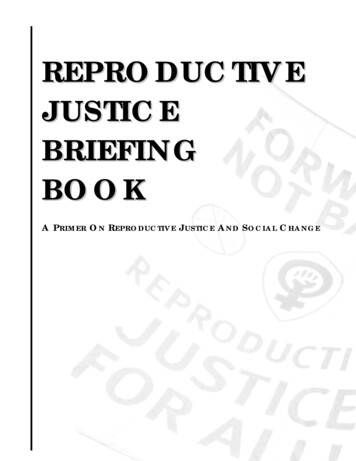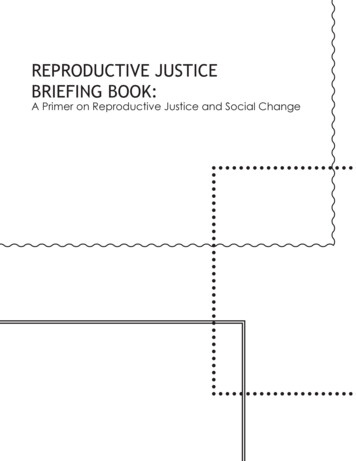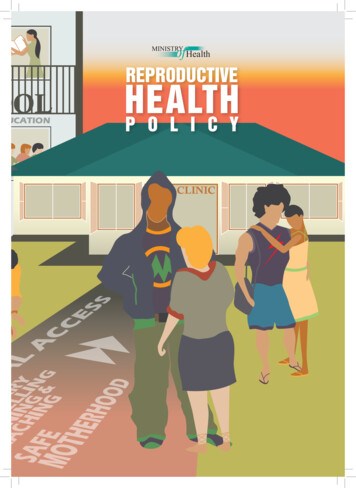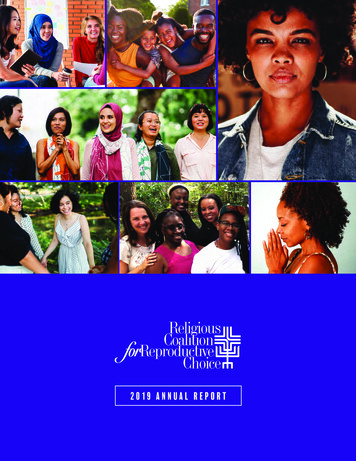
Transcription
REPRODUCTIVEJUSTICEBRIEFINGBOOKA PRIMER ON REPRODUCTIVE JUSTICE AND SOCIAL CHANGE
REPRODUCTIVE JUSTICE BRIEFING BOOKTABLE OF CONTENTSWhat Is Reproductive Justice? by Loretta Ross, SisterSong Women of Color ReproductiveHealth Collective4Listen Up!: How to Connect with Young Women Through Reproductive Justice by MaryMahoney, Pro-Choice Public Education Project6Abstinence-Only and Reproductive Injustice by John Santelli, MD, MPH; RebeccaSchleifer, JD, MPH; and Lila Lande, MPH8Abstinence-Only-Until-Marriage Programs Censor Vital Health Care Information,Jeopardizing Teens’ Health by Lorraine Kenny, American Civil Liberties Union10Youth and Adults Changing Sex Education by Yessenia Cervantes, Illinois Caucus forAdolescent Health11Young Women, Egg “Donation,” and Reproductive Justice by Emily Galpern, Center forGenetics and Society, and Edith Sargon, Choice USA12Girlmom: We are Young/Teen Moms and Pro-Choice by Girlmom14Sex, Lies and Birth Control: What You Need to Know About Your Birth Control Campaign byCommittee on Women, Population and the Environment17Birth Control and Gender Justice by Cristina Page19Pharmacists’ Refusals and Reproductive Justice by Carole Joffe, University of California,Davis20Medicaid and Women’s Reproductive Health by National Women’s Law Center22Reproductive Justice and Health Care Reform by National Women’s Law Center24Abortion Rights and Reproductive Justice by Marlene Fried, Civil Liberties and Public PolicyProgram, Hampshire College and Susan Yanow25The Personal is Political: Abortion Stigma and Reproductive Justice by Grayson Dempsey,Backline27When Roe v. Wade Falls, Who Will Catch Us? by Rebecca Trotzky Sirr, Medical Student,University of Minnesota28Regulating “Choice”: Sterilization Abuse in the United States, Then and Now by JaimeAnno, MPH Candidate, Mailman School of Public Health, Columbia University30Race, Class and Perspectives on Reproductive Matters by Amy Allina, National Women’sHealth Network32Thinking South: Locating a Reproductive Justice Movement by Paris Hatcher, SPARK!Reproductive Justice NOW33The Hyde Amendment Violates Reproductive Justice and Discriminates Against PoorWomen and Women of Color by Stephanie Poggi, National Network of Abortion Funds341
Reproductive Justice and Women of Color by Toni M. Bond Leonard, African AmericanWomen Evolving35Reproductive Justice Issues for Asian and Pacific Islander Women by Maria Nakae, AsianCommunities for Reproductive Justice36Reproductive Justice and Lesbian, Gay Bisexual and Transgender Liberation by AlisaWellek and Miriam Yeung38Immigrant Rights and Reproductive Justice by Jessica Gonzalez-Rojas and Aishia Glasford,National Latina Institute for Reproductive Health40Made in the USA: Advancing Reproductive Justice in the Immigration Debate by PriscillaHuang, National Asian Pacific American Women’s Forum41Incarcerated Women and Reproductive Justice by Rachel Roth43Reproductive Justice: A Movement of Resistance Led by Girls and Transgirls Involved inthe Sex Trade and Street Economy by Young Women’s Empowerment Project45Disabled Women and Reproductive Justice by Mia Mingus, SPARK! Reproductive JusticeNOW46The Myth of the Norm: Genetic Technologies and the De-Selection of Disabled Bodies: AReproductive Justice Perspective by Mia Mingus, SPARK! Reproductive Justice NOW, andPatty Berne, Center for Genetics and Society48Reproductive Justice for All Pregnant Women by Lynn Paltrow, National Advocates forPregnant Women50Men and Reproductive Justice Rus Ervin Funk, MensWork: Eliminating Violence AgainstWomen, Inc.52Adoption and Reproductive Justice by Laura Briggs, University of Arizona54Transnational and Transracial Adoption: The Right of Poor Women of Color to Keep andRaise Their Children by Jane Jeong Trenka, Sun Yung Shin, Julia Chinyere Oparah, JaeRan Kim, and Shannon Gibney56Foster Care and Reproductive Justice by Dorothy Roberts, Northwestern University57Assisted Reproductive Technologies and Reproductive Justice by the National Gender,Eugenics & Biotechnology Task Force and Staff Members of the Committee on Women,Population and the Environment5810 Reasons to Rethink Overpopulation by the Population and Development Program atHampshire College60Environmental Justice: Woman is the First Environment by Katsi Cook, Mohawk Nation atAkwesasne62Spirituality: A Tool to Achieve Reproductive Justice by Emily P. Goodstein, Spiritual Youthfor Reproductive Freedom642
Reproductive Justice Worldwide: Opposition to Women’s Rights at the United Nations byPam Chamberlain, Political Research Associates66The Challenges of Reproductive Justice in Eastern Europe by Joanna Mistal, Ph.D.,Mailman School of Public Health, Columbia University68Law, Medicine and Morality: The Threat to Reproductive Justice by Lois Uttley,MergerWatch Project69Using International Human Rights Law to Advance Reproductive Justice by KatrinaAnderson, Center for Reproductive Rights71Reproductive Justice Requires Equal Treatment and Constitutional Protection for PregnantWomen by Jill C. Morrison, National Women’s Law Center73Some How-tos on Using Media as a Reproductive Justice Organizing Tool by ArielDoughtery75The Incompatibility of Neo-Liberal “Choice” and Reproductive Justice by Rickie Solinger77Abortion Matters to Reproductive Justice! by Leila Hessini, Lonna Hays, Emily Turner andSarah Packer, IPAS79Conditions of Reproductive Justice by Rickie Solinger813
WHAT IS REPRODUCTIVE JUSTICE?By Loretta Ross, SisterSong Women of Color Reproductive Health CollectiveReproductive Justice is the complete physical, mental, spiritual, political, social, and economicwell-being of women and girls, based on the full achievement and protection of women’shuman rights. This definition as outlined by Asian Communities for Reproductive Justice (ACRJ)offers a new perspective on reproductive issues advocacy, pointing out that for Indigenouswomen and women of color it is important to fight equally for (1) the right to have a child; (2)the right not to have a child; and (3) the right to parent the children we have, as well as tocontrol our birthing options, such as midwifery. We also fight for the necessary enablingconditions to realize these rights. This is in contrast to the singular focus on abortion by the prochoice movement that excludes other social justice movements.The Reproductive Justice framework analyzes how the ability of any woman to determine herown reproductive destiny is linked directly to the conditions in her community—and theseconditions are not just a matter of individual choice and access. Reproductive Justiceaddresses the social reality of inequality, specifically, the inequality of opportunities that wehave to control our reproductive destiny. Moving beyond a demand for privacy and respect forindividual decision making to include the social supports necessary for our individual decisions tobe optimally realized, this framework also includes obligations from our government forprotecting women’s human rights. Our options for making choices have to be safe, affordableand accessible, three minimal cornerstones of government support for all individual lifedecisions.One of the key problems addressed by Reproductive Justice is the isolation of abortion fromother social justice issues that concern communities of color: issues of economic justice, theenvironment, immigrants’ rights, disability rights, discrimination based on race and sexualorientation, and a host of other community-centered concerns. These issues directly affect anindividual woman’s decision-making process. By shifting the focus to reproductive oppression—the control and exploitation of women, girls, and individuals through our bodies, sexuality, labor,and reproduction—rather than a narrow focus on protecting the legal right to abortion,SisterSong Women of Color Reproductive Health Collective is developing a more inclusive visionof how to build a new movement.Because reproductive oppression affects women’s lives in multiple ways, a multi-prongedapproach is needed to fight this exploitation and advance the well-being of women and girls.There are three main frameworks for fighting reproductive oppression defined by ACRJ:Reproductive Health, which deals with service deliveryReproductive Rights, which addresses legal issues, andReproductive Justice, which focuses on movement buildingAlthough these frameworks are distinct in their approaches, they work together to provide acomprehensive solution. Ultimately, as in any movement, all three components—service,advocacy and organizing—are crucial.The Reproductive Justice analysis offers a framework for empowering women and girls relevantto every family. Instead of focusing on the means—a divisive debate on abortion and birthcontrol that neglects the real-life experiences of women and girls—the Reproductive Justiceanalysis focuses on the ends: better lives for women, healthier families, and sustainablecommunities. This is a clear and consistent message for all social justice movements. Using thisanalysis, we can integrate multiple issues and bring together constituencies that are multi-racial,multi-generational, and multi-class in order to build a more powerful and relevant grassrootsmovement.4
Reproductive Justice focuses on organizing women, girls and their communities to challengestructural power inequalities in a comprehensive and transformative process of empowermentthat is based on SisterSong’s self-help practices that link the personal to the political.Reproductive Justice can be used as a theory for thinking about how to connect the dots in ourlives. It is also a strategy for bringing together social justice movements. But also, it is a practice –a way of analyzing our lives through the art of telling our stories to realize our visions and bringfresh passion to our work.The key strategies for achieving this vision include supporting the leadership and power of themost excluded groups of women, girls and individuals within a culturally relevant context. This willrequire holding ourselves and our allies accountable to the integrity of this vision. We have toaddress directly the inequitable distribution of power and resources within the movement,holding our allies and ourselves responsible for constructing principled, collaborativerelationships that end the exploitation and competition within our movement. We also have tobuild the social, political and economic power of low-income women, Indigenous women,women of color, and their communities so that they are full participating partners in building thisnew movement. This requires integrating grassroots issues and constituencies that are multiracial, multi-generational and multi-class into the national policy arena, as well as into theorganizations that represent the movement.SisterSong is building a network of allied social justice and human rights organizations thatintegrate the reproductive justice analysis into their work. We are using strategies of self-help andempowerment so that women who receive our services understand they are vital emergingleaders in determining the scope and direction of the Reproductive Justice and social justicemovements.RESOURCESIn order to find out more about Reproductive Justice, please visit the following .org5
LISTEN UP!: HOW TO CONNECT WITH YOUNG WOMEN THROUGH REPRODUCTIVE JUSTICEBy Mary Mahoney, Pro-Choice Public Education ProjectNow, I don’t want to say this too loudly to a movement that already has so much on its plate,but the reproductive health and rights of young women must become a greater priority for amovement whose viability depends on the activism of youth to survive.We have recently experienced some landmark developments in our field, such as the FDAapproval of the human papilloma virus (HPV) vaccine Gardasil and prescription-free EmergencyContraception for people over 18. But until we can assure reproductive autonomy for all youngpeople, we have little time to pat ourselves on the back.Historically, adults, even progressive women in the reproductive rights movement, have acted asif they know best what young women need – and have typically only listened to young womenwith one ear. So what can we do as a movement to support young women in the fight againstreproductive oppression and in the struggle for reproductive justice?There are many ways to create and support spaces for young women’s voices within thismovement and to connect with them by focusing on their needs rather than our own agendas.First, young people are growing up in a culture that exploits teen sexuality and at the same timedenies it outright. No matter how resilient young people may be, they can’t help beingaffected by images from Girls Gone Wild commercials and Laguna Beach. The media alsoharm youth by ignoring their public health needs: in the top 200 films of the past 20 years,condom use was only suggested once! Is unsafe sex still considered sexy? With so manyinnovative and entertaining advancements in technology and medicine, like musical condomsand chewable birth control, you would think Hollywood could do a better job of creating a safe,realistic space for youth to contemplate sexual activity.Government policies directly harm young people. Between 1996 and 2005, Congresscommitted over 1.1 billion through both federal and state matching funds to “abstinence-only”programs. Virtually no money went to comprehensive sex education. Today the only sexeducation for more than a third of all students is “abstinence only,” even though this curriculumteaches falsehoods about condom effectiveness rates and other matters. LGBTQ youth arecompletely disregarded as sexual beings under this curriculum. Young women are being askedto take total responsibility for their bodies without access to education that would teach themhow to make safe choices.“Abstinence-only” programs respond to young people’s reproductive and sexual health as amoral issue, not a public health issue. This, even while the number of new cases of STDs among15-24 year olds is 9.1 million or roughly fifty percent of all new cases in the U.S, including 15,000HIV/AIDS and 4.6 million HPV cases. Government and market-driven policies that block youngpeople from healthy sexual choices also include parental notification laws for abortion accessand regulations governing emergency contraception (EC) which mandate prescriptions for girlsyounger than 18, even though this makes it difficult for young women to obtain EC within the 72hour window, and even though this restriction assumes that all young women have healthinsurance or money to visit their doctor and also assumes that they have doctors they trust.Today young people want to address reproductive issues in their own, contemporary terms,focusing on prevention and families and healthy futures. We who advocate for and promotethe activism of young women in the reproductive rights and health movement can support thisactivism with a reproductive justice framework. This framework looks at the whole woman andher entire set of life circumstances, from age to class to race to religion to sexual orientation,recognizing that these interconnected issues affect how she – and others – control herreproductive health and rights. In other words, it is important that we do not isolate abortion6
from the totality of women’s health and lives and do not alienate potential activists by focusingonly on this one issue.Young women completely understand this holistic approach to reproductive health and rights.They, along with women of color led groups, are transforming the movement to include accessto health care, LGBTQ liberation, racial and economic justice, comprehensive sex education,maternal dignity and HIV/AIDS work. Young women are mobilizing their peers and constituenciesby creating messages that connect with young people and working across movements to buildthe progressive and social justice movements from the ground up. Because what we choose todo today not only affects the lives of youths at present, but also their future health and ability tomake smart choices for themselves throughout their lives, becoming involved in this area of themovement is an important step for any activist or organization. To support young women in thismovement, we must follow their lead and meet them where they are on their road toreproductive autonomy.RESOURCESFor more information on young women and reproductive justice issues: Pro-Choice Public Education Project – www.protectchoice.org Choice USA – www.choiceusa.org Advocates for Youth – www.advocatesforyouth.org Asian Communities for Reproductive Justice – www.reproductivejustice.org7
ABSTINENCE-ONLY AND REPRODUCTIVE INJUSTICEBased on the presentation “Abstinence and U.S. Abstinence-Only Education Policies: Ethical andHuman Rights Concerns” by John S Santelli, MD, MPH, Rebecca Schleifer, JD, MPH and Lila JLande, MPHAbstinence promotion raises important ethical and human rights concerns when abstinence ispresented to adolescents as the sole choice while health information on other choices isrestricted or misrepresented. Access to complete and accurate HIV/AIDS and sexual healthinformation has been recognized as a basic human right and essential to realizing the humanright to the highest attainable standard of health. Abstinence-only restrictions put healtheducators and other health professionals in an ethical quandary, forcing them to choose towithhold potentially life-saving information or to breach federal government guidelines bydisclosing such information.The emphasis on “abstinence-only” educational programs in the U.S. causes systematic harm todomestic public health programs and may harm international HIV- prevention programs.Human rights groups criticized U.S. government policy as a source for misinformation andcensorship in some countries receiving The President’s Emergency Plan for AIDS Relief (HumanRights Watch, 2004). The Government Accountability Office, which is the investigative arm ofU.S. Congress, issued a critique of U.S. foreign policy support for “abstinence-only” education inApril 2006.Governments have an obligation to provide accurate information to their citizens and avoid theprovision of misinformation. Such obligations extend to government-funded health educationand health care services. Access to accurate health information as a basic human right wasexplained in the 1994 International Conference on Population and Development Programme ofAction. These principles include universal access to health care services and specificallyhighlight reproductive health stating that “All couples and individuals have the basic right todecide freely and responsibly the number and spacing of their children and to have theinformation, education and means to do so” (United Nations, 1994). The U.N. Committee on theRights of the Child emphasized in 2003, “that effective HIV/AIDS prevention requires States torefrain from censoring, withholding, or intentionally misrepresenting health-related information,including sexual education and information State parties must ensure that children have theability to acquire the knowledge and skills to protect themselves and others as they begin toexpress their sexuality” (Committee on the Rights of the Child, 2003).As defined by the U.S. government’s funding requirements, “abstinence-only” programs mustwithhold information on contraception and other aspects of human sexuality. These programsalso promote scientifically questionable positions. It is unethical to provide misinformation orwithhold information from adolescents about sexual health, including ways for sexually activeteens to protect themselves from sexually transmitted infections and pregnancy. These currentU.S. polices are ethically problematic, as they exclude accurate information aboutcontraception, misinform by overemphasizing or misstating the risks of contraception, and fail torequire the use of scientifically accurate information.While health care ethics is founded on the notion of informed consent and free choice, U.S.federal “abstinence-only” programs are inherently coercive, withholding information needed tomake informed choices and promoting questionable and inaccurate opinions. “Abstinenceonly” programs are inconsistent with internationally accepted notions of human rights.“Abstinence-only” as a basis for health policy and programs should be abandoned.RESOURCES Advocates for Youth - www.advocatesforyouth.org/sexeducation.htm American Civil Liberties Union:o Take Issue Take Charge Campaign - www.takeissuetakecharge.org8
Reproductive Freedom Project 1201.htmlHuman Rights Watch – www.hrw.orgLegal Momentum – www.legalmomentum.orgSexuality Information and Education Council of the United States - www.siecus.orgSociety for Adolescent Medicine - www.adolescenthealth.orgo 9
ABSTINENCE-ONLY-UNTIL-MARRIAGE PROGRAMS CENSOR VITAL HEALTH CARE INFORMATION,JEOPARDIZING TEENS’ HEALTHby Lorraine Kenny, American Civil Liberties UnionSince 1996, Congress has allocated more than a billion dollars for programs that focus exclusivelyon abstinence-until-marriage and censor other information that can help young people makeresponsible, healthy, and safe decisions about sexual activity. There is no conclusive evidencethat these programs reduce the rate of unintended pregnancy or sexually transmitted diseases(STDs). And to make matters worse, there is evidence that they deter sexually active teens fromusing condoms and other contraceptives.To receive federal funds, abstinence-only-until-marriage programs must offer curricula that haveas their “exclusive purpose” teaching the benefits of abstinence. In addition, recipients offederal abstinence-only dollars may not advocate contraceptive use or teach contraceptivemethods except to emphasize their failure rates. Thus, grantees are forced either to omit anymention of topics such as contraception, abortion, homosexuality, and AIDS or to present thesesubjects in an incomplete and inaccurate manner.Pushing misinformation about sex flies in the face of reality and fails to address young people’shealth needs. Engaging in sex before marriage is the cultural norm and has been for decades.Nearly two-thirds of all high school seniors have had sex, and considering the high rate of teenpregnancy and STD transmission in the United States, the need for accurate information couldn’tbe greater.Abstinence-only-until-marriage programs don’t stop at disseminating harmful misinformationabout sex. They are also often rife with gender stereotypes and can have harmful effects onlesbian and gay teens. Many curricula dangerously stigmatize homosexuality. In a society thatgenerally prohibits gays and lesbians from marrying, singling out marriage as the sole relationshipin which sex is appropriate rejects the idea of same-sex sexual intimacy. Furthermore, many ofthe leading curricula address same-sex behavior only within the context of promiscuity anddisease. All of this adds up to create a hostile environment for lesbian and gay students as wellas for teens growing up with lesbian, gay, and/or single parents.Ultimately, parents, teachers, and major medical groups, including the American MedicalAssociation, the American Academy of Pediatrics, and the American College of Obstetrics andGynecology, support comprehensive sexuality education that stresses both abstinence and alsoprovides students with complete and accurate information about how to protect themselvesfrom unintended pregnancy and STDs. There is ample evidence that programs that includecomplete and accurate information about sex reduce sexual risk-taking and pregnancy amongteens.RESOURCES Take Issue, Take Charge campaign - http://www.takeissuetakecharge.org SIECUS State Profiles - http://www.siecus.org/policy/states/index.html Guttmacher Institute - Facts on Sex Education in the United States http://www.guttmacher.org/pubs/fb sexEd2006.html10
YOUTH AND ADULTS CHANGING SEX EDUCATIONBy Yessenia Cervantes, Illinois Caucus for Adolescent Health Youth LeaderThree years ago, students from a Chicago high school joined forces with the Illinois Caucus forAdolescent Health (ICAH) in order to press the Chicago Public Schools (CPS) to providecomprehensive sex education. Unfortunately, Chicago Public Schools had inconsistentstandards regarding sex education, including a very ambiguous definition of what informationteachers could provide.A group of students at Curie High School, along with their history teacher, Michael Smith,created an activist leadership class called Forefront—which in life’s mysterious ways, ended uppartnering with ICAH. Later these students and ICAH reached out to other schools andorganizations to join in the struggle to implement a realistic, reliable and responsible sexualeducation curriculum. Students themselves were clear about the need for such a curriculum.They reported that a majority of their health instructors presented either abstinence-onlyprograms or no sexual education at all! Plus, there was inadequate funding for comprehensivecurricula and no real training available for teachers who would be responsible of these classes.The first step at Curie High School was to meet directly with the principal and physical educationteachers, the ones responsible for teaching sexual education to the freshman class, the onlygrade where these topics were discussed at all. Unfortunately, the teachers did not welcomethe concerns that the students voiced. Nevertheless, Forefront, with advice, training andguidance from ICAH, continued with a series of meetings with the local school council andprincipal. After a year, Curie’s local school council provided a bit of money that the studentsused to purchase materials so that they could take on the role of sexual educators themselves,and so that they could continue to pursue this issue outside of their school. The principal alsoimplemented a comprehensive sex education curriculum in a particular class.In the second year of “the struggle,” ICAH convened other youth working across the city toadvocate for similar changes in their schools. The coalition took its concerns to the streets,organizing two rallies downtown at the CPS headquarters. One was held in a summer downpourand the other during a winter freeze.Finally, the students got a seat at the table with top officials within CPS to shape a new policy.The coalition mobilized other organizations, parents, teachers, doctors, legislators, and evenclergy to show up at the school board meeting in support of a comprehensive curriculum. On abeautiful spring day in April of 2006, the Chicago Board of Education unanimously passed theFamily Life and Comprehensive Sexual Health Education policy mandating the teaching ofcomprehensive sex education in grades 6-12 and training for all teachers providing thiseducation, and seating a student representative on the panel that approves all curricula used inCPS.There is still much work to be done to implement this policy, to pass policies in other communitiesthroughout the state, and to redirect our federal and state tax dollars to programs that reallyserve the needs of Illinois youth. However, we know that with a collaborative effort betweenyouth and adults and with commitment to see our efforts through to real change, we can makesexual education a reality in this state and in our country.RESOURCES Illinois Caucus for Adolescent Health - www.icah.org Illinois Campaign for Responsible Sex Education - www.responsiblesexed.org Advocates for Youth - www.advocatesforyouth.org Sex, etc. www.sexetc.org My Sistahs - www.mysistahs.org11
YOUNG WOMEN, EGG “DONATION,” AND REPRODUCTIVE JUSTICEBy Emily Galpern, Center for Genetics and Society, and Edith Sargon, Choice USAThe use of new reproductive technologies can pose both benefits and risks to women. While thetechnologies have enabled millions of people around the world to have genetically-relatedchildren, they have the potential to decrease women’s decision-making power, and certainmethods have not been sufficiently tested. One practice that has largely gone unquestioned ispaying young women to provide “donor eggs” to a woman undergoing in vitro fertilization whocannot conceive using her own eggs. While most women who have provided eggs for thisprocedure have said they don’t do it only for the money, the majority say they would not havegone through the procedure if they hadn’t been paid. The procedure is invasive, carries someknown short-term risk, and the long term health risks are unknown.Young women are specifically recruited for their eggs because they generally have more andbetter quality eggs. College campuses are inundated with advertising because they provideeasy access to a large pool of highly educated young women with specific “desiredcharacteristics,” such as high SAT scores; athletic, mathematic, or musical ability; and specificethnicities. Many women in college are also faced with high tuition and/or debt, making themprime targets for paid egg “donation.”Egg donors are recruited through fertility clinics, egg brokers, or by private solicitation. Desiredqualities are often listed in ads, along with rates of compensation, ranging from 5,000 to 100,000 (the more specific the desired qualities, the higher the payment). Egg “donation” (inquotes because since the women are paid, these are not donations) raises reproductive justiceconcerns about health risks, exploitation, and commodification of young women’s reproductivetissue.PROCEDUREWomen inject three different hormones over the course of 4-6 weeks to “shut down” theirovaries, then “hyperstimulate” them in order to control the timing of the release of the matureeggs. This is followed by a surgical procedure under light anesthesia, during which an ultrasoundguided needle is inserted through the vaginal wall into the ovary and the eggs are sucti
By Loretta Ross, SisterSong Women of Color Reproductive Health Collective Reproductive Justice is the complete physical, mental, spiritual, political, social, and economic well-being of women and girls, based on the full achievement and protection of women's human rights. This definition as outlined by Asian Communities for Reproductive .










